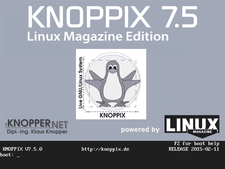Knoppix 7.5
Live Linux

Knoppix 7.5 is based on the current development version of Debian GNU/Linux and comes with hardware support from kernel 3.18 including many updates and new features.
The DVD in this month's issue is the exclusive Linux Magazine Edition of Knoppix 7.5, released in conjunction with the CeBIT 2015 Exhibition and Conference for IT and Digital Business in Hannover, Germany. This newest release from Klaus Knopper incorporates a number of new features, including kernel 3.18.6, Xorg 7.7 with core server 1.16.2 for hardware support, a custom SysVinit package for boot up, a small 12MB "boot only" CD ISO for those who cannot boot from a USB flash drive, a menu entry for the ClamAV scanner, the Knock kernel patch, an SSH server and client with TCP Stealth support, a number of new packages, and updates to standard software.
Debian systemd
Although you can find reasons for and against the use of systemd, the decision made by the Debian team to change the default boot system, along with tight integration by systemd of many system services, has greatly increased the complexity of system startup and made adjustments to the process difficult, especially when compared with the relatively primitive SysVinit.
The boot system in Knoppix, essentially comprising a single startup script for hardware detection and parallel launching of critical system components (knoppix-autoconfig) remains the same because it has its own SysVinit package. Systemd's own SysV replacement is not used in Knoppix, although the other systemd components are installed to resolve dependencies. This means that Knoppix boots up the same way it always has, unlike the Debian base since "jessie".
[...]
Buy this article as PDF
(incl. VAT)
